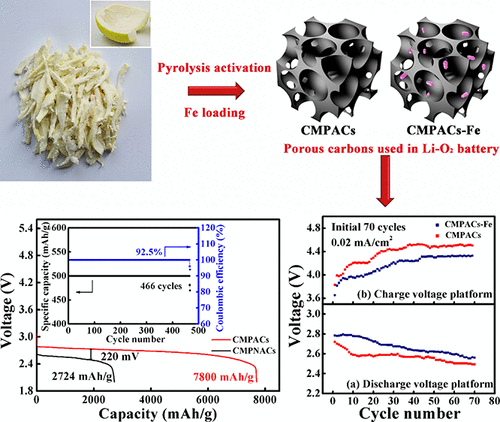当前位置:
X-MOL 学术
›
ACS Appl. Mater. Interfaces
›
论文详情
Our official English website, www.x-mol.net, welcomes your
feedback! (Note: you will need to create a separate account there.)
New Application of Waste Citrus Maxima Peel-Derived Carbon as an Oxygen Electrode Material for Lithium Oxygen Batteries
ACS Applied Materials & Interfaces ( IF 8.3 ) Pub Date : 2018-08-24 00:00:00 , DOI: 10.1021/acsami.8b07212 Danrong Li 1 , Qingzhen Wang 1 , Ying Yao 1 , Feng Wu 1 , Yajuan Yu 1 , Cunzhong Zhang 1
ACS Applied Materials & Interfaces ( IF 8.3 ) Pub Date : 2018-08-24 00:00:00 , DOI: 10.1021/acsami.8b07212 Danrong Li 1 , Qingzhen Wang 1 , Ying Yao 1 , Feng Wu 1 , Yajuan Yu 1 , Cunzhong Zhang 1
Affiliation

|
Recently, lithium oxygen battery has become a promising candidate to satisfy the current large-energy-storage devices demand because of its amazing theoretical energy density. However, it still faces problems such as poor reversibility and short cycle life. Here, citrus maxima peel (CMP) was used as a precursor to prepare activated and Fe-loading carbon (CMPACs and CMPACs-Fe, respectively) via pyrolysis in nitrogen atmosphere at 900 °C, in which KOH was added as an activator. Electrochemical measurements show that CMPAC-based Li–O2 battery possesses high specific capacity of 7800 mA h/g, steady cycling performance of 466 cycles with a corresponding Coulombic efficiency of 92.5%, good rate capability, and reversibility. Besides, CMPACs-Fe-based O2 electrode delivers even lower overpotential in both charge and discharge processes. We conclude that these excellent electrochemical performances of CMPACs and CMPACs-Fe-based O2 electrode benefit from their cellular porous structure, plenty of active sites, and large specific surface area (900 and 768 m2/g), which suggest that these biomass-derived porous carbons might become promising candidates to achieve efficient lithium oxygen battery.
中文翻译:

柑桔废皮衍生碳作为锂氧电池氧电极材料的新应用
近来,锂氧电池因其惊人的理论能量密度而成为满足当前大型储能装置需求的有前途的候选者。但是,它仍然面临诸如可逆性差和循环寿命短的问题。在这里,柑桔皮(CMP)被用作前体,通过在氮气氛中900°C的高温下热解制备活性炭和负载Fe的碳(分别为CMPAC和CMPAC-Fe),其中添加了KOH作为活化剂。电化学测量结果表明,基于CMPAC的Li–O 2电池具有7800 mA h / g的高比容量,466个循环的稳定循环性能,相应的库仑效率为92.5%,良好的倍率能力和可逆性。此外,CMPACs-Fe基O 2电极在充电和放电过程中甚至提供了更低的过电势。我们的结论是,CMPAC和CMPACs-Fe基O 2电极的这些出色的电化学性能得益于它们的细胞多孔结构,大量的活性位点和较大的比表面积(900和768 m 2 / g),这表明这些生物质衍生的多孔碳可能成为实现高效锂氧电池的有前途的候选者。
更新日期:2018-08-24
中文翻译:

柑桔废皮衍生碳作为锂氧电池氧电极材料的新应用
近来,锂氧电池因其惊人的理论能量密度而成为满足当前大型储能装置需求的有前途的候选者。但是,它仍然面临诸如可逆性差和循环寿命短的问题。在这里,柑桔皮(CMP)被用作前体,通过在氮气氛中900°C的高温下热解制备活性炭和负载Fe的碳(分别为CMPAC和CMPAC-Fe),其中添加了KOH作为活化剂。电化学测量结果表明,基于CMPAC的Li–O 2电池具有7800 mA h / g的高比容量,466个循环的稳定循环性能,相应的库仑效率为92.5%,良好的倍率能力和可逆性。此外,CMPACs-Fe基O 2电极在充电和放电过程中甚至提供了更低的过电势。我们的结论是,CMPAC和CMPACs-Fe基O 2电极的这些出色的电化学性能得益于它们的细胞多孔结构,大量的活性位点和较大的比表面积(900和768 m 2 / g),这表明这些生物质衍生的多孔碳可能成为实现高效锂氧电池的有前途的候选者。

































 京公网安备 11010802027423号
京公网安备 11010802027423号